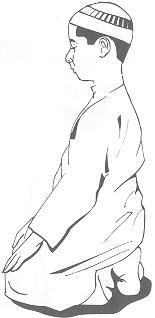 Once you have completed your prostration you should raise your head while saying Allaahu Abkar and sit on your left thigh with your right foot propped upwards on its toes; your back should be straight, and your forearms should be on your thighs.
Once you have completed your prostration you should raise your head while saying Allaahu Abkar and sit on your left thigh with your right foot propped upwards on its toes; your back should be straight, and your forearms should be on your thighs.
There is another way of sitting that the Prophet (may the peace and blessings of Allah be upon him) used to do and that is to rest upon both heels and all of the toes, and this form of sitting should only be used in this place in the prayer.
You should remain in this position until your body is at ease and all of your bones are in their natural positions. At this point, you should supplicate. There are two authentic supplications mentioned that the Prophet Muhammad (may the peace and blessings of Allah be upon him) would make at this point:
The first one is:
رَبِّ اغْفِرْ لِي ، رَبِّ اغْفِرْ لِي
Transliteration: rabbigh-fir lee, rabbigh-fir lee
Translation: My Lord forgive me, My Lord forgive me.
The second one is:
اللَّهُمَّ اغْفِرْ لِي وَارْحَمْنِي وَاجْبُرْنِي وَاهْدِنِي وَارْزُقْنِي
Transliteration: allaahumm-agh-fir lee, warḥamnee, wajburnee, wahdinee, warzuqnee.
Translation: O Allah, forgive me, have mercy upon me, give me strength, guide me, give and grant me sustenance.
Note that the Prophet (may the peace and blessings of Allah be upon him) would make this sitting the same length of time that the prostration took.
The description of everything mentioned above can be found in the following narrations:
It was narrated that Abū Mas'ood (may Allah be pleased with him) said:
"The Prophet (may the peace and blessings of Allah be upon him) would be relaxed until every bone returned to its (proper) position (when he got up from sujood), and he ordered "The prayer of one of you is not complete until he does this (sits upright straightening his spine)". [Ibn Mājah: 870]
It was narrated from Al-Qasim who narrated from 'Abdullah-he is Ibn Abdullah ibn 'Umar- that: His father (Ibn 'Umar) said:
"One of the sunnahs of the prayer is to hold the right foot upright and point its toes toward the Qiblah, and to sit on the left foot."[an-Nasā'ī: 1158]
'Abdullaah ibn Az-Zubair (May Allah be pleased with him) said:
"When the Messenger of Allah (may the peace and blessings of Allah be upon him) sat during the prayer (at the tashahhud), he placed his left foot under his right thigh and shin and spread his right foot and placed his left hand on his left knee and placed his right hand on his right thigh, and he pointed with his forefinger." [Abū Dāwood: 988]
Ṭāwoos (may Allah have mercy on him) said:
"We asked Ibn 'Abbās about sitting on heels between the two prostrations. He said: 'It is the Sunnah.' We said: 'We look upon it as a pressure on the foot'. He said: 'This is the Sunnah of your Prophet (may the peace and blessings of Allah be upon him)'." [Abū Dāwood: 845]
al-Barā' (May Allah be pleased with him) narrated:
"The time taken by the Prophet (may the peace and blessings of Allah be upon him) during prostrations, bowing, and sitting between the two prostrations was about the same." [al-Bukhārī: 820]